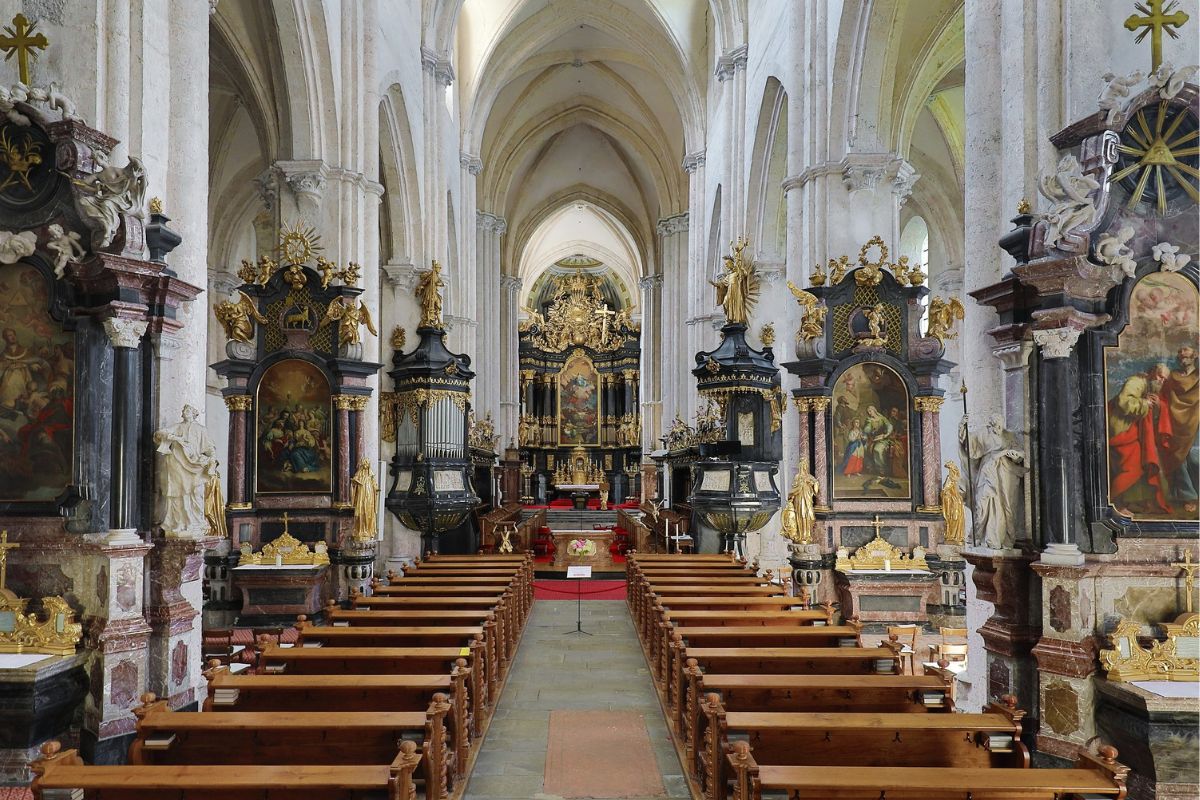
Lilienfeld Abbey is a hidden gem nestled in the heart of Austria. Founded in 1202 by Leopold VI, this Cistercian monastery has a rich history and stunning architecture that captivates visitors. Did you know that Lilienfeld Abbey houses one of the oldest libraries in Austria, boasting over 40,000 volumes? The abbey's church is a masterpiece of Gothic design, featuring intricate stained glass windows and a majestic high altar. Beyond its architectural beauty, the abbey played a significant role in the region's cultural and spiritual life. Whether you're a history buff, architecture enthusiast, or simply curious, Lilienfeld Abbey offers a fascinating glimpse into medieval monastic life. Ready to uncover more intriguing facts about this historic site? Let's dive in!
Key Takeaways:
- Lilienfeld Abbey, founded in 1202, is a historic Cistercian monastery in Austria, known for its architectural marvels, cultural treasures, and contributions to science and tradition.
- With its blend of Romanesque and Gothic architecture, Lilienfeld Abbey continues to be a place of worship, culture, and community, attracting visitors with its serene surroundings, unique traditions, and educational programs.
The Origins of Lilienfeld Abbey
Lilienfeld Abbey, located in Austria, is a Cistercian monastery with a rich history. Let's explore some fascinating facts about this historic site.
-
Founded in 1202: Lilienfeld Abbey was established by Leopold VI, Duke of Austria, in 1202. It was part of the Cistercian order, which emphasized simplicity and self-sufficiency.
-
Named After Lilies: The name "Lilienfeld" translates to "Field of Lilies," symbolizing purity and the Virgin Mary, to whom the abbey is dedicated.
Architectural Marvels
The abbey's architecture is a blend of Romanesque and Gothic styles, showcasing the evolution of medieval European design.
-
Largest Cistercian Church in Austria: The abbey church is the largest of its kind in Austria, measuring 82 meters in length and 22 meters in width.
-
Gothic Choir Stalls: The choir stalls, carved in the 14th century, are a stunning example of Gothic woodwork, featuring intricate designs and figures.
-
Romanesque Cloister: The cloister, built in the Romanesque style, is one of the oldest parts of the abbey, providing a peaceful space for meditation and prayer.
Historical Significance
Lilienfeld Abbey has played a crucial role in Austrian history, influencing religion, culture, and politics.
-
Burial Site of Leopold VI: Duke Leopold VI, the founder, was buried in the abbey church in 1230, making it a significant historical site.
-
Center of Learning: The abbey housed a scriptorium where monks copied and preserved important manuscripts, contributing to the spread of knowledge.
-
Influence on Local Economy: The abbey owned vast lands and was involved in agriculture, viticulture, and forestry, boosting the local economy.
Art and Culture
The abbey is home to numerous artistic treasures and cultural artifacts.
-
Baroque Library: The library, built in the 18th century, contains over 40,000 volumes, including rare manuscripts and early printed books.
-
Frescoes by Paul Troger: The abbey church features stunning frescoes by the renowned Baroque painter Paul Troger, depicting scenes from the life of Christ.
-
Organ by Johann Hencke: The church's organ, built by Johann Hencke in 1746, is still in use today and is known for its exceptional sound quality.
Modern-Day Lilienfeld Abbey
Today, Lilienfeld Abbey continues to be a place of worship, culture, and community.
-
Active Monastic Community: The abbey is still home to a community of Cistercian monks who follow the Rule of St. Benedict.
-
Tourist Attraction: The abbey attracts thousands of visitors each year, offering guided tours, concerts, and cultural events.
-
Educational Programs: The abbey hosts educational programs and workshops on topics such as theology, history, and art.
Natural Surroundings
The abbey is nestled in a picturesque landscape, adding to its serene and tranquil atmosphere.
-
Located in the Vienna Woods: The abbey is situated in the Vienna Woods, a beautiful forested area that provides a peaceful retreat.
-
Herb Garden: The monks maintain a herb garden, growing medicinal plants and herbs used in traditional remedies.
-
Pilgrimage Route: Lilienfeld Abbey is a stop on the Via Sacra pilgrimage route, attracting pilgrims from around the world.
Unique Traditions
Lilienfeld Abbey has preserved many unique traditions and practices over the centuries.
-
Annual Lilienfeld Festival: The abbey hosts an annual festival celebrating its history and cultural heritage, featuring music, dance, and traditional crafts.
-
Monastic Brewing: The monks brew their own beer, following centuries-old recipes, which is available for purchase at the abbey.
-
Christmas Market: Each year, the abbey holds a Christmas market, offering handmade crafts, local produce, and festive treats.
Contributions to Science
The abbey has also made significant contributions to scientific research and discovery.
-
Astronomical Observations: In the 18th century, the abbey's monks conducted astronomical observations, contributing to the field of astronomy.
-
Botanical Studies: The monks have documented and studied the local flora, contributing to botanical knowledge and conservation efforts.
Final Thoughts on Lilienfeld Abbey
Lilienfeld Abbey stands as a testament to history, culture, and architectural brilliance. Founded in 1202, this Cistercian monastery has weathered centuries, witnessing significant events and housing countless artifacts. Its library, with over 40,000 volumes, is a treasure trove for historians and book lovers alike. The abbey's architecture, blending Romanesque and Gothic styles, showcases the craftsmanship of bygone eras. Visitors can marvel at the intricate details of the cloisters, the grandeur of the church, and the serene beauty of the gardens. Beyond its physical beauty, Lilienfeld Abbey offers a glimpse into the spiritual and cultural life of medieval Europe. Whether you're a history buff, an architecture enthusiast, or someone seeking a peaceful retreat, Lilienfeld Abbey promises a rich and rewarding experience. Its enduring legacy continues to inspire and captivate all who visit.
Frequently Asked Questions
Was this page helpful?
Our commitment to delivering trustworthy and engaging content is at the heart of what we do. Each fact on our site is contributed by real users like you, bringing a wealth of diverse insights and information. To ensure the highest standards of accuracy and reliability, our dedicated editors meticulously review each submission. This process guarantees that the facts we share are not only fascinating but also credible. Trust in our commitment to quality and authenticity as you explore and learn with us.


